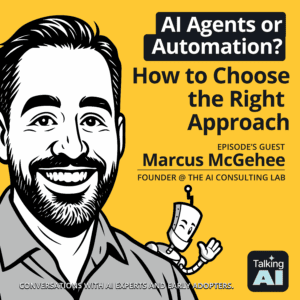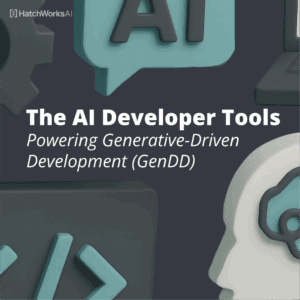Odds are, your employees are experimenting with Generative Artificial Intelligence (Generative AI) in their roles.
Asking ChatGPT for feedback, using it to brainstorm, and a million other use cases they’ve been inspired to try out from their network on LinkedIn.
But is their use part of a wider strategy to put your business ahead? Could it make businesses operate in a way that is more structured, more encouraged, and more efficient?
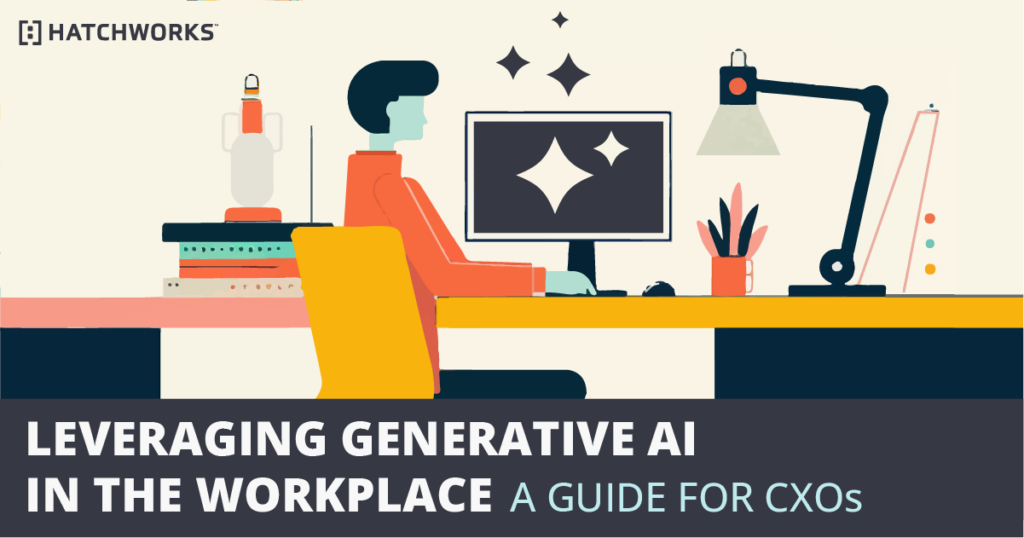
We think so. In fact, we know so. Because we saw it happening in our own company. We decided to optimize our use of AI technology and integrate it into our entire business (including the full software development lifecycle) so that we’re on the cutting edge in our industry, not falling behind.
To help other businesses do similar, we’ve written this guide.
Here’s what you can expect:
- The Evolution of AI Employees in the Modern Workplace
- Understanding Generative AI and Its Capabilities
- Generative AI Tools: The Models Transforming Business Processes
- Integrating Generative AI into Your Business Strategy: Practical Tips
- Navigating the Challenges of AI Adoption
- Skills Development for AI-Enhanced Workforce
- Learn How to Leverage AI in Your Organization with HatchWorks
The Evolution Generative AI for the Workplace
🔑 Key takeaway: Not only have the capabilities of AI increased dramatically, it has become accessible to all of your employees in a way it never was before—right at their personal computer.
It wasn’t more than a few years ago that AI systems in the workplace were rudimentary, capable only of assisting in basic data analysis and automating simple repetitive tasks and mundane tasks only.
Some were sophisticated enough to identify patterns using AI algorithms. But none were capable of ‘thinking’ for themselves.
And none were readily accessible. Only people with advanced skills knew how to use or build AI. And businesses needed AI or Machine Learning developers on hand to take advantage of the new technology.
That’s all changed now. With the introduction of Gen AI, workplace tools like Robotic Process Automation seem old-hat and the complexity of tools that run on older AI models (think your video call software and web searches) are taken for granted.
That’s because Gen AI can problem-solve, identify patterns in vast datasets, and come up with new ideas just like a human would—offering ai generated insights that guide decision making. It’s the closest we’ve come to true intelligence from AI and it’s transformed it from a mere tool to a quasi-employee with capabilities that complement human capabilities.
Anyone with internet access can leverage these AI assistants, many of which come in the form of virtual assistants and ai powered chatbots. Many models are free to use or are available for a small monthly subscription fee. This democratization of access has opened the floodgates for experimentation. People can even build their own GPTs and offer them to others.
As we move forward, it won’t be if you use AI at work, it will be how you use AI at work.
How effectively you harness Gen AI for specific tasks, factor in human oversight, and incorporate AI tool after AI tool will dictate your potential for success as a business—and your competitive advantage.
Gen AI: Impact on the Labor Market
As soon as Gen AI tools gained momentum and racked up millions of users, questions emerged about what this meant for the labor market and the humans who hold those jobs.
- Were we further down the path of replacing human workers than we thought?
- Would businesses use AI technology and the opportunities AI presents as an excuse to reduce headcount?
- Would there be a need for new jobs and skills?
We’re starting to get our answers.
Labor Shortages? What Labor Shortages
One of those answers is that Gen AI is fixing labor shortages in industries like software development.
How do we know? An IBM report from 2022 says so. In fact, they showed that 25% of surveyed companies have turned to AI adoption to address human labor shortages.
And it’s not surprising.
We hear all the time how there aren’t enough software developers out there to complete all of the projects businesses want. If AI can make one software developer as productive as two or more, you can move quicker on the projects that really matter.
We’ve done it ourselves. Our developers were quick to experiment with Gen AI, testing how machine learning techniques could improve productivity and shorten the time to deliver projects.
As a result, we adapted our software development process and have increased our efficiency. It’s called Generative-Driven Development™ and our clients have seen a 30-50% productivity increase since its introduction.
A word from a HatchWorks client on how AI has improved our service:
We have trusted HatchWorks with our most strategic development projects for over five years. Their Nearshore model, combined with their AI capabilities, has been a game-changer for our software development practice."
Taryn Owen, President & CEO, TrueBlue
If you’ve faced issues in the past with getting enough talent to complete lucrative software projects and are interested in how we can help, get in touch here.
AI is Projected to Create More Jobs than It Steals
Some studies predict significant job losses due to automation and AI. But they also show promise of new human-centered roles. When AI takes over mundane tasks, humans can shift towards more meaningful work that leverages human skills, creativity, and emotional intelligence.
The World Economic Forum projected that AI could result in the loss of 85 million jobs worldwide by 2025 but also generate 97 million new jobs, indicating a net positive effect of technological advancements on employment.
However, that data is from 2020 and we’ve been through a Pandemic and an economic slump since then. Not to mention ChatGPT didn’t exist. Luckily, WEF’s more recent 2023 report still shows a future promise of growth:
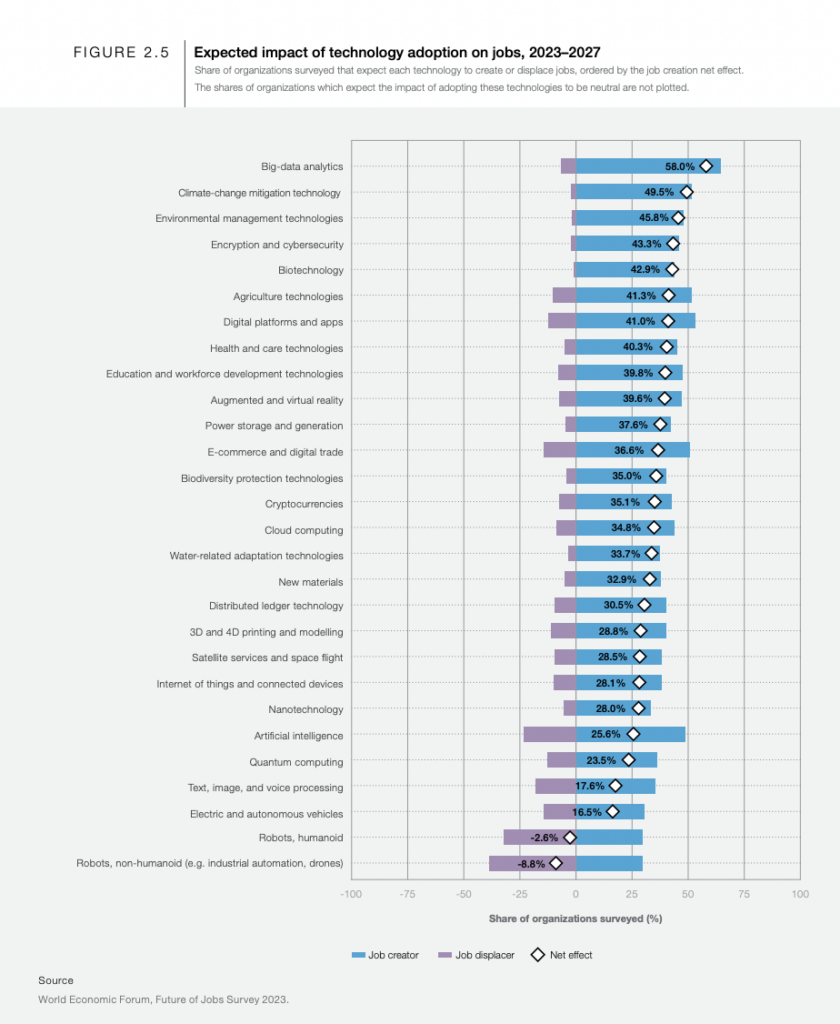
Skills Expectations Have Changed
Many jobs, new and old, will require human expertise in AI-related skills and AI literacy. After all, companies will need human employees who know how to use their artificial intelligence counterparts effectively.
We’re seeing demand for AI-related skills already, not only in technical roles but also in non-technical positions. LinkedIn’s 2023 Future of Work Report highlighted the growth in companies hiring for AI-specific roles and the increase in job postings mentioning AI technologies like ChatGPT.
This suggests a broadening scope of AI’s impact on the workforce, requiring a wide range of professionals to adapt and acquire new skills.
As roles evolve, hr leaders will be pivotal in facilitating upskilling and reskilling initiatives to ensure the workforce meets these new demands. Those who can combine AI capabilities with human oversight will find that AI enables better employee engagement and job satisfaction, as they are freed from the drudgery of automating mundane tasks and can focus on higher-level problem-solving.
It’s a sentiment backed up by AI experts like Heather Murray, who we had as a guest on the Talking AI podcast:
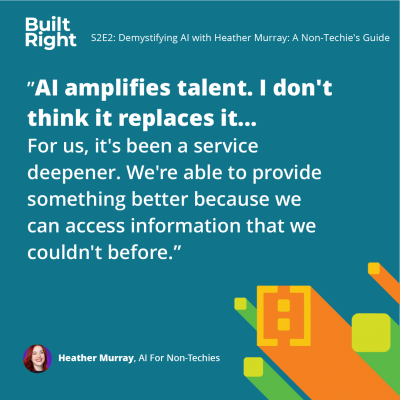
Understanding AI Systems and Capabilities
At its core, Generative AI uses training data, machine learning algorithms, and natural language processing to produce content that mimics human-like outputs.
It’s a step beyond traditional AI capabilities, leveraging existing information to generate new, original pieces of text, images, music, and more, that were not explicitly programmed.
Businesses are using it to help them scale content marketing, software development, customer support, product development, and to drive better decision making faster.
When people think of Gen AI, they usually think of ChatGPT. But it’s not the only tool available and there are plenty more of them businesses can use to get ahead, or at the very least, keep up!
📚 Further reading: 2024’s Comprehensive Guide to Generative AI: Techniques, Tools & Trends
Generative AI Tools: The Models Transforming Business Processes
We’ve outlined some top Gen AI models, their applications, and their significant benefits, as well as the potential risks like data privacy concerns or incorrect outputs.
📚 For a deeper dive: Generative AI Use Case Trends Across Industries: A Strategic Report
GitHub Copilot – For Your Software Development Team
GitHub Copilot is powered by OpenAI’s Codex and acts as an AI pair programmer. It suggests code snippets and entire functions in real time. It’s integrated directly into Visual Studio Code, making it accessible for developers during the coding process.| Benefits | Challenges |
|---|---|
|
Improves Productivity: Significantly speeds up coding by providing instant suggestions.
|
Accuracy Concerns: May suggest incorrect or insecure code, requiring careful review.
|
|
Enhances Learning: Helps new developers learn programming languages and best practices.
|
Dependency Risk: Developers may become overly reliant on suggestions, potentially stunting skill development.
|
Want to learn more about how Gen AI can further enhance productivity in software development? Check out our article: Harnessing Generative AI Tools for Modern Software Development.
ChatGPT 3 & 4 – An All-Rounder (Marketing, Software Dev., Product, Sales, Finance, etc.)
GPT-3, developed by OpenAI, is one of the most powerful language processing AI models available, capable of understanding and generating human-like text.
Businesses can integrate Chat GPT into their systems via API for a variety of tasks, including content creation, customer service, and coding assistance.
| Benefits | Challenges |
|---|---|
|
Versatility: Can be applied to a wide range of language tasks.
|
Cost: Accessing GPT-3 through API can be expensive for high-volume usage.
|
|
High-Quality Output: Generates coherent and contextually relevant text.
|
Complex Integration: Requires technical expertise to integrate and manage effectively.
|
TensorFlow for Software Developers
TensorFlow is an open-source platform for machine learning that offers a broad range of tools and libraries for developers to build and deploy AI models. It includes TensorFlow CodeGen for automating the generation of machine learning model code.
| Benefits | Challenges |
|---|---|
|
Flexibility: Supports multiple AI tasks, including NLP and image recognition.
|
Learning Curve: Can be complex for beginners to grasp.
|
|
Strong Community Support: Extensive documentation and a large community.
|
Resource Intensive: Requires significant computational resources for training models.
|
Hugging Face’s Transformers for Customer Experience
Transformers by Hugging Face provides a comprehensive collection of pre-trained models for natural language processing (NLP), including translation, content generation, and sentiment analysis. They enable easy integration of advanced AI capabilities into applications.
Their library of pre-trained NLP models is also open-sourced with users able to share both models and datasets. This accessibility and rapid testing helps the AI develop even faster.
You can now also create your own AI virtual assistants functioning similar to custom GPTs in ChatGPT.
| Benefits | Challenges |
|---|---|
|
Ease of Use: Simplifies the integration of advanced NLP capabilities.
|
Model Complexity: Some models may be too complex for certain applications, leading to inefficiency.
|
|
Community and Support: Regular updates and a supportive community.
|
Data Privacy: When using cloud-based models, data privacy can be a concern for sensitive information.
|
Codex by OpenAI – For Your Software Development Team
Codex is a descendant of GPT-3 tailored specifically for understanding and generating programming code. It powers GitHub Copilot but can also be integrated into other development environments to assist in code generation and documentation.| Benefits | Challenges |
|---|---|
|
Enhanced Coding Efficiency: Provides accurate code suggestions, reducing coding time.
|
Overreliance: Potential for developers to rely too much on AI, impacting learning and problem-solving skills.
|
|
Broad Language Support: Understands and generates code in multiple programming languages.
|
Quality Control: Generated code may require review and testing to ensure it meets standards.
|
AWS Code Whisper
AWS CodeWhisperer, developed by Amazon, is a machine learning-powered service that provides code recommendations to help developers build applications faster. It integrates with popular IDEs to offer real-time suggestions.| Benefits | Challenges |
|---|---|
|
Boosts Development Speed: Offers real-time coding suggestions, accelerating project completion.
|
Dependency Concerns: Relying heavily on suggestions might limit learning and problem-solving growth.
|
|
Personalized Recommendations: Learns from your coding patterns to provide tailored advice.
|
Integration Limitations: Best suited for environments that support AWS integration.
|
Sofy AI
Sofy AI is a platform that automates software testing, utilizing AI to conduct tests efficiently and effectively across various devices and platforms. It’s great for mobile testing your software projects quickly and efficiently.| Benefits | Challenges |
|---|---|
|
Improves Testing Efficiency: Automates repetitive testing tasks, freeing up human resources for complex testing scenarios.
|
Complex Setup: Initial configuration and integration into existing development workflows can be complex.
|
|
Enhanced Accuracy: Reduces the likelihood of human error in testing processes.
|
Adaptability: May require adjustments or manual intervention for highly specific or novel testing scenarios.
|
MidJourney
MidJourney is an innovative tool designed to assist creative professionals by generating visual content. It leverages generative AI to transform textual descriptions into detailed images. The results are incredibly realistic.| Benefits | Challenges |
|---|---|
|
Enhances Creative Processes: Provides a new way to visualize ideas and concepts quickly.
|
Creative Control: While powerful, it may not always align perfectly with specific creative visions.
|
|
Streamlines Content Creation: Reduces the time and resources needed for producing visual assets.
|
Learning Curve: Requires understanding best practices for prompt crafting to achieve desired outcomes.
|
Integrating Generative AI into Your Business Strategy: Practical Tips
Integrating AI into business processes offers the most significant benefits yet.
It leads to efficiency gains, reduces mundane task, sparks innovation, and opens new avenues for personalization and more customer satisfaction and engagement.
But these benefits aren’t achieved overnight. Businesses need to set their teams up for AI success so they can reap the rewards more seamlessly.
Here’s how:
Define Clear AI Objectives
Determine specific areas where Generative AI can enhance creativity and efficiency, such as in software development, content creation, product design, customer interaction, and even decision making.
Setting clear, measurable goals will guide the focus of your AI initiatives, ensuring they align with broader business objectives and contribute to gaining a competitive advantage.
Build Data Infrastructure
When integrating Generative AI, specifically Large Language Models (LLMs) into your systems, there’s a distinction in approach. If you’re using tools like ChatGPT for brainstorming or analysis directly, extensive training might not be required as these models come pre-trained.
However, for tailored applications—where the AI needs to understand your specific business context or data—fine-tuning with your own datasets becomes essential. This ensures the AI’s outputs are closely aligned with your business needs, enhancing its effectiveness in your unique environment.
Cultivate Generative AI Talent and Culture (focusing on human skills and AI literacy)
Focus on developing a workforce proficient in Generative AI by providing specialized skills training and recruiting talent with experience in using generative artificial intelligence models.
Encouraging a culture of innovation and experimentation is key to fully leveraging Generative AI’s potential.
You also need to give them access to the right tools. If there are better Gen AI models available and your team is using the outdated one, then you’re not getting the most out of the tools available to you.
Implement Ethical Standards for Generative AI
Generative AI excels at creating new content, Given this, it’s crucial to establish ethical guidelines that address copyright issues, intellectual property, authenticity, and the ethical use of generated outputs.
These standards will guide responsible use and foster trust in your AI-driven initiatives.
Evaluate and Iterate Generative AI Applications
Regularly assess the impact of Generative AI on your various business processes, from improving product development cycles to improving productivity and enhancing customer engagement.
Be agile in iterating your approach based on performance metrics and evolving technology trends to maximize the benefits of Generative AI.
Navigating the Challenges of AI Adoption
Integrating Gen AI in the workplace is a transformative journey that comes with its own set of challenges and risks. Identifying these challenges at early stages and applying strategic solutions can ensure a smoother transition and successful integration.
Resistance to Change
Challenge: Organizations often face resistance from employees and business leaders who fear AI may replace their jobs or disrupt their workflow.
Solution: Foster an inclusive culture that emphasizes AI as a tool for enhancement, not replacement. Engage employees in training programs to demystify AI, showcasing how it can ease their workload , unlock innovation, and improve performance.
Integration Complexity
Challenge: Merging Gen AI with existing systems can be technically complex and resource-intensive.
Solution: Start with pilot projects to understand integration challenges better. Utilize external expertise if necessary and ensure there’s a clear roadmap for technology integration that aligns with business goals.
Data Privacy and Security
Challenge: Gen AI systems require access to vast amounts of data, raising concerns over privacy and security.
Solution: Implement stringent data collection and governance policies and use encryption and anonymization techniques to protect sensitive information. Educate stakeholders about data protection regulations and the measures in place to secure data.
Ethical Considerations
Challenge: Integrating Gen AI into the workplace raises questions about fairness, bias, and accountability in automated systems.
Solution: Develop and implement ethical guidelines that govern AI use, ensuring that AI applications are transparent, equitable, and respect privacy.
This includes conducting regular audits of Gen AI systems for bias and involving diverse stakeholders in discussions on AI ethics.
Emphasizing ethical considerations in AI use not only aligns with regulatory expectations but also builds trust with employees and customers, reinforcing the organization’s commitment to responsible innovation.
You can also build out guides and resources on what ethical AI use looks like and the standards you expect employees to uphold.
Measuring ROI
Challenge: Demonstrating the immediate value of AI investments can be difficult, as benefits may accrue over time.
Solution: Define clear, measurable objectives for AI projects from the outset just as you would when setting parameters for worker productivity and performance. Use performance metrics that can track both short-term gains and long-term impact on efficiency and innovation.
⚠️ But don’t let ROI prevent you from getting started.
Like any new disruptive and transformative technology, effectively measuring a return will be difficult.
Missing out on the benefit of Gen AI is by far a bigger risk.
Skills Development for AI-Enhanced Workforce
For employees to thrive in an AI-enhanced workplace, you need to give them the resources, opportunity, and encouragement to develop new skills.
It’s not just technical skills they’ll need either but human creativity, critical thinking, problem-solving, and adaptability. Those will help your team work alongside AI.
Training, however, should focus on understanding AI technologies, advanced algorithms, data analysis, and how to interact with AI systems effectively.
You can implement mentorship programs, lead workshops, and offer online courses to support continuous learning and development.
At HatchWorks, we’ve built a suite of training opportunities businesses can use to get up to speed on using Generative AI in the workplace.
Check them out here:
The Role of Leadership in Fostering an AI-Friendly Culture
By championing AI initiatives and demonstrating a commitment to continuous learning and innovation, leaders can foster innovation and inspire confidence and enthusiasm for AI across all levels of the organization.
This involves not only investing in necessary new technologies and training but also encouraging open dialogue about AI’s potential and addressing any concerns proactively to foster an environment where AI can thrive and contribute to the organization’s success.
You can hold an all-hands meeting where you address questions about the parameters around AI use at the company, talk about upcoming webinars and workshops on the topic, and remind your team to showcase examples of AI success stories.
Learn How to Leverage AI and Machine Learning in Your Organization with HatchWorks
Building upon the essential skills of critical thinking, problem-solving, and adaptability, HatchWorks offers two pivotal programs to elevate your organization’s AI readiness.
Gen AI Innovation Workshop
Transform your team’s understanding and application of AI with HatchWorks’ Gen AI Innovation Workshop. It’s a full-day training experience that equips you with the necessary skills to apply AI in real-world scenarios, ensuring your organization becomes AI-fluent through unique ideation, building a proof of concept, and crafting a tailored action plan.
Gen AI Solution Accelerator
Accelerate your AI project timeline with HatchWorks’ Gen AI Solution Accelerator. This two to eight-week program provides a structured pathway from concept to prototype, offering guidance on technology selection, data preparation, and in-depth documentation, culminating in a clear path to full-scale production.
With HatchWorks’ expert guidance, start your project with confidence and ensure your team is prepared for the AI-enhanced future of work.
Make Your C-Suite AI-Ready
AI Training for Executives equips your leadership team with strategic insight and real-world frameworks to drive AI-powered transformation—tailored to your business.

